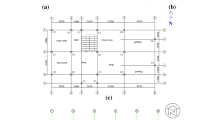Abstract
The seismic performance of low-rise intermediate steel moment frame buildings following design practices of South Korea was investigated and its benefit was presented in comparison with those of customary design practice in the United States. The major features in the design and construction practices in South Korea are that the entire frames of the building are designed to resist the lateral load and beam-to-column connections are fabricated in factories. In contrast, in the United States, only exterior frames resist the lateral load and the entire beam-to-column connections are welded at the construction site. To investigate the effects of distinctive design practices on seismic performance, the example buildings were designed and evaluated with the procedure in FEMA 355F. The effect of panel zone deformation in addition to story drift was considered in performance evaluation. The evaluation results showed that the seismic performance of the buildings designed in accordance with the practice in South Korea were not significantly different from those in the United States. Therefore, design and construction practices in South Korea are a competitive way for intermediate steel moment frame buildings.
Similar content being viewed by others
References
AIK (2009). Korean building code-structural. Architectural Institute of Korea, Seoul, South Korea.
ANSI/AISC 341 (2010). Seismic provisions for structural steel buildings. American Institute of Steel Construction, Chicago, IL.
ANSI/AISC 360 (2010). Specification for structural steel buildings. American Institute of Steel Construction, Chicago, IL.
ASCE/SEI 7 (2010). Minimum design loads for buildings and other structures. American Society of Civil Engineers, Reston, VA.
Cornell, C. A., Jalayer, F., Hamburger, R. O., and Foutch, D. A. (2002). “Probabilistic basis for 2000 SAC federal emergency management agency steel moment frame guidelines.” Journal of Structural Engineering, ASCE, 128(4), pp. 526–533
FEMA 350 (2000). Recommended seismic design criteria for new steel moment-frame buildings. Federal Emergency Management Agency, Washington, D.C.
FEMA 355F (2000). State of the art report on performance prediction and evaluation of steel moment-frame buildings. Federal Emergency Management Agency, Washington, D.C.
Gupta, A. and Krawinkler, H. (1998). Seismic Demands for performance evaluation of steel moment resisting frame structures. The John A. Blume Earthquake Engineering Center, Stanford University, Stanford, CA.
ICC (2000). International building code. International Code Council, Inc., Birmingham, AL.
Jalayer, F. and Cornell, C. A. (2003). A Technical framework for probability-based demand and capacity factor design (DCFD) seismic formats. PEER Report 2003/8, Pacific Earthquake Engineering Center, University of California at Berkeley, Berkeley, CA.
Kim, T., Foutch, D. A., Wilcoski, J., and LaFave, J. M. (2009). “Response modification factors for RC case-study buildings with structural walls.” Earthquake Spectra, Earthquake Engineering Research Institute, 25(4), pp. 803–819
Lee, C. H. and Park, J. W. (1998). “Cyclic seismic testing of full-scale column-tree type steel moment connections.” Journal of Korean Society of Steel Construction, Korean Society of Steel Construction, 10(4), pp. 629–639
Lee, K. and Foutch, D. A. (2002a). “Seismic performance evaluation of pre-Northridge steel frame buildings with brittle connections.” Journal of Structural Engineering, ASCE, 128(4), pp. 546–555
Lee, K. and Foutch, D. A. (2002b). “Performance evaluation of new steel frame buildings for seismic loads.” Earthquake Engineering and Structural Dynamics, WILEY, 31(3), pp. 653–670
OpenSees-open system for earthquake engineering simulation. http://opensees.berkeley.edu.
Somerville, P., Smith, N., Puntamurthula, S., and Sun, J. (1997). Development of ground motion time histories for phase 2 of the FEMA/SAC steel project. SAC Background Document Report No. SAC/BD-97/04, SAC Joint Venture, Richmond, CA.
Vamvatsikos, D. and Cornell, C. A. (2002). “Incremental dynamic analysis.” Earthquake Engineering and Structural Dynamics, WILEY, 31(3), pp. 491–514
Yun, S.Y., Hamburger, R. O., Cornell, C. A., and Foutch, D. A. (2002). “Seismic performance evaluation for steel moment frames.” Journal of Structural Engineering, ASCE, 128(4), pp. 534–545
Author information
Authors and Affiliations
Corresponding author
Rights and permissions
About this article
Cite this article
Kim, T., Yu, E. Seismic performance of low-rise intermediate steel moment frame buildings in South Korea. Int J Steel Struct 17, 1331–1340 (2017). https://doi.org/10.1007/s13296-017-1205-x
Received:
Accepted:
Published:
Issue Date:
DOI: https://doi.org/10.1007/s13296-017-1205-x




